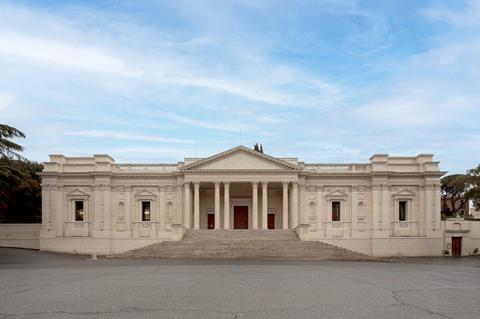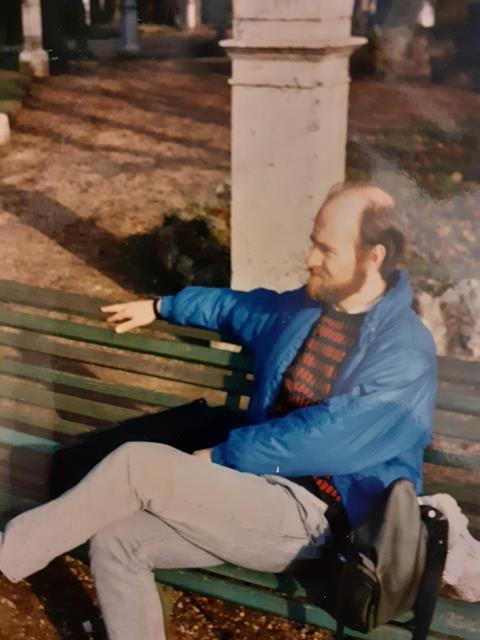In this interview Eleanor Jolliffe discovers how the opportunity to study in Rome changed the course of a renowned academic’s life

Climbing the dome of the Pantheon and looking down through the Oculus at the room below. Climbing the scaffolding in the Sistine Chapel and seeing the ceiling up close during restoration. Climbing the scaffolding around a part restored Trajan’s column and coming literally face to face with the reliefs. Nicholas Temple’s experience of Rome was second to none.
Of course this wasn’t a holiday, this kind of access to Rome is rare, and the connections that make it possible are one of the joys of being at the British School at Rome (BSR). The late Amanda Claridge was at the BSR at this point as Assistant Director and had used her contacts in archaeology to give the BSR’s scholars access to these remarkable sites.
Nicholas Temple is now Senior Professor Emeritus in Architectural History at London Metropolitan University and is the author and editor of several books on aspects of Rome and Italy, including Architecture and the Language Debate: Artistic and Linguistic Exchanges in Early Modern Italy and The Routledge Handbook on the Reception of Classical Architecture. However, in 1986 at the BSR he was a Part 2 graduate from Cambridge on a two year scholarship to study the Early Christian Baptistry at the Basilica of St John the Lateran.

The topic of his study grew at the BSR and encompassed further sites and ceremonies of initiation and public ritual. He spent hours in the Vatican and Herziana libraries absorbing information on pagan rites, miasma stains, and the transportation of water through Rome. As Temple put it, “the more I read the more I realised I didn’t know”.
He travelled to Ravenna to visit the Orthodox and Arian baptistries, Milan and Parma to explore the legacy of Early Christian and Medieval baptismal rites. And he took side-trips to Sicily, Puglia, Naples, Reggio Calabria, Paestum, Florence, Urbino, Arezzo and Borgo San Sepolcro with artists and archaeologists he had met at the BSR.
One trip during his studies in Rome took him to Turkey and Greece to visit other archaeological sites, always discovering more about Italy, its wider influences and its centuries of ritual.
He became absorbed by the topography of Rome, fascinated by its reworking under each new historic regime. Even the topography spoke to the rituals he was discovering, steeped in legends around the history and foundations of the city.
While academia had never seemed an option for Temple this time at the BSR proved to be formative. After his return to the UK he registered as an architect during the recession of the early 1990s. The call of his BSR interests resurfaced and Temple started a PhD at Leeds Metropolitan University whilst teaching as a lecturer in architecture, hoping to make a career that was a hybrid of practice and academia.

This was followed by a period as an assistant professor at the University of Pennsylvania where Temple taught on the PhD programme with Joseph Rykwert and David Leatherbarrow and delivered seminars on the topography of Rome.
Temple’s interest in Rome and ceremony continued. Indeed his 2011 book, Renovatio Urbis: Architecture, Urbanism and Ceremony in the Rome of Julius II, is a study of the architecture, urbanism and ceremony of early 16th century Rome, a fascinating period in Rome’s history as the Early Renaissance transitions to the High Renaissance.
It wasn’t just the ideas from his scholarship that drew Temple back to the BSR though. He was later awarded the Paul Mellon Fellowship there in 2012 to study the influence of the Chinese in 18th Century Europe; and he used the BSR as a base for several research trips including recently while researching a book on the Chinese and European understanding of the temporality in buildings.
The call of Rome’s ceremonies has developed into an interest in the movement of cultural ideas through the world, always gravitating back towards Rome. Temple is passionate about his subject, arguing that we are too ignorant of architectural and cultural history, and that in studying the ritual and material culture of the past we can shed new light on current worries, including climate change.
Our conversation sidetracked into a fascinating insight into the broader relevance of architectural history that I don’t have space for here, but which reminded me of an aspect of life at the BSR that Temple also remembers well – the generosity of its residents with their knowledge and experience. It is a place where you bump into people, with a culture that discourages the insular, or those too protective or ‘mean’ with their knowledge.
Temple is clear- the experience of the BSR was life changing. He is fearful for its future in a world in which the more intangible nature of its benefits are hard to demonstrate in a funding climate in which all experience must be seen to be immediately ‘relevant’. Experiencing Rome is, he argues, central to contemporary issues.
The value of time in the city is insight and understanding into our own position. The time he was granted there was a privilege, and it’s an experience he hopes many future generations can also enjoy.
The BSR in two words according to Temple? Scholarly and camaraderie.
Postscript
Nicholas Temple is a senior professor of architectural history at the School of Art, Architecture and Design at London Metropolitan University. He is also the Director of the Centre for Urban and Built Ecologies.
















No comments yet